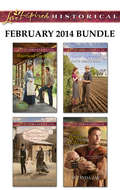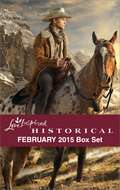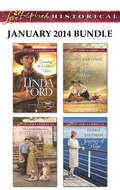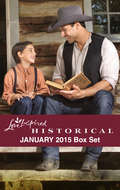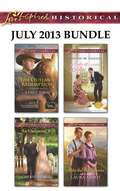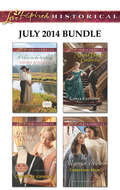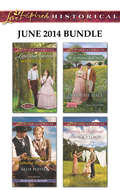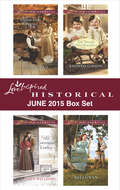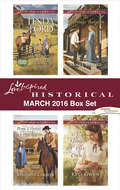- Table View
- List View
Love Inspired Historical December 2015 Box Set
by Linda Ford Winnie Griggs Rhonda Gibson Jo Ann BrownLove Inspired Historical brings you four new titles at a great value, available now! Enjoy these historical romances of adventure and faith. A HOME FOR CHRISTMAS Christmas in Eden Valley by Linda Ford Cowboy Wade Snyder is determined to find his orphaned niece and nephew a loving adoptive home. But soon temporary nanny Missy Porter and the children make him wonder if his wounded heart can find healing with this ready-made family.THE HOLIDAY COURTSHIP Texas Grooms by Winnie Griggs Bachelor Hank Chandler suddenly finds himself guardian to his sister's two orphaned children. He'll need all the help he can get from sweet schoolteacher Janell Whitman--but could falling in love turn these strangers into a family? A CONVENIENT CHRISTMAS BRIDE by Rhonda Gibson When Josiah Miller rescues Anna Mae Leland from a blizzard, he never expects he'll soon be proposing a marriage of convenience for the sake of his children. But when she's stranded on his farm and later loses her teaching job, honor dictates that Josiah marry her. HER LONGED-FOR FAMILY Matchmaking Babies by Jo Ann Brown Lady Caroline Trelawney Dowling has always wanted a child of her own and her dreams come true when she becomes caregiver to two abandoned children. What will it take for Lady Caroline to convince her neighbor, Lord Jacob Warrick, that there's a place for him in her life, too?
Love Inspired Historical December 2017 Box Set: His Frontier Christmas Family\Once Upon a Texas Christmas\The Gift of Twins\Would-Be Mistletoe Wife
by Winnie Griggs Christine Johnson Regina Scott Gabrielle MeyerLove Inspired Historical brings you four new titles! Enjoy these historical romances of adventure and faith.HIS FRONTIER CHRISTMAS FAMILYFrontier Bachelorsby Regina ScottNewly appointed as guardian of his late friend’s siblings and baby daughter, preacher Levi Wallin opens his home to them and their elder sister, Callie Murphy—a woman he can’t help but fall for at Christmastime.ONCE UPON A TEXAS CHRISTMASTexas Groomsby Winnie GriggsAfter arriving in Texas to revamp a hotel during the holiday season, Seth Reynolds clashes with the young woman assigned to help him. But when Seth starts to care for feisty Abigail Fulton, will he have to choose between business and love?WOULD-BE MISTLETOE WIFEBoom Town Bridesby Christine JohnsonWorried she might lose her teaching job when funding is cut for the boarding school, widow Louise Smythe must consider marriage. But the only prospective groom in town is lighthouse-keeper Jesse Hammond, and he wants children—something she may never be able to provide.THE GIFT OF TWINSLittle Falls Legacyby Gabrielle MeyerWhen twin five-year-old boys are left on Reverend Benjamin Lahaye’s doorstep, he and schoolteacher Emmy Wilkes work together to care for the children. But can their temporary makeshift family become permanent?
Love Inspired Historical February 2014 Bundle
by Lyn Cote Patty Smith Hall Sherri Shackelford Milinda JayLove Inspired Historical brings you four new titles for one great price, available now! This Love Inspired Historical bundle includes Heartland Courtship by Lyn Cote, The Marshal's Ready-Made Family by Sherri Shackelford, Hearts Rekindled by Patty Smith Hall and Her Roman Protector by Milinda Jay.Look for four new inspirational suspense stories every month from Love Inspired Suspense!
Love Inspired Historical February 2015 Box Set
by Linda Ford Janet Lee Barton Barbara Phinney Sherri ShackelfordLove Inspired Historical brings you four new titles for one great price, available now! This Love Inspired Historical bundle includes Big Sky Homecoming by Linda Ford, The Engagement Bargain by Sherri Shackelford, Sheltered by the Warrior by Barbara Phinney and A Daughter's Return by Janet Lee Barton.Look for 4 new inspirational suspense stories every month from Love Inspired Historical!
Love Inspired Historical February 2016 Box Set
by Karen Kirst Noelle Marchand Lily George Stacy HenrieLove Inspired Historical brings you four new titles at a great value, available now! Enjoy these historical romances of adventure and faith. RECLAIMING HIS PAST Smoky Mountain Matches Karen Kirst When Jessica O'Malley discovers a wounded stranger with amnesia in her barn, she nurses him back to health. But she isn't sure if she can trust him, especially since nobody knows who he is...or what he was doing on her property.THE TEXAN'S ENGAGEMENT AGREEMENT Bachelor List Matches Noelle Marchand Determined to thwart their parents' matchmaking schemes, former sweethearts Chris Johansen and Adelaide Harper pretend to be engaged. But can they stop their make-believe courtship from developing into something real?THE EXPRESS RIDER'S LADY Stacy Henrie Intent on attending her sister's wedding, Delsie Radford hires Pony Express rider Myles Patton to escort her from Missouri to California. Will they arrive on time to reunite the sisters--and possibly find love along the way?A PRACTICAL PARTNERSHIP Lily George Marriage was never part of the plan for Hannah Siddons or John Reed. But when John convinces Hannah to help him prepare his sister for her debut, sparks begin to fly--and they must decide whether to follow their hearts. Join HarlequinMyRewards.com to earn FREE books and more. Earn points for all your Harlequin purchases from wherever you shop.
Love Inspired Historical February 2017 Box Set: Wed by Necessity\The Outlaw's Secret\The Bounty Hunter's Baby\The Reluctant Guardian
by Karen Kirst Stacy Henrie Erica Vetsch Susanne DietzeLove Inspired Historical brings you four new titles! Enjoy these historical romances of adventure and faith.WED BY NECESSITYSmoky Mountain Matchesby Karen KirstCaught in a storm overnight with her father’s new employee, Caroline Turner’s reputation is damaged. And the only way to repair it is to marry Duncan McKenna. But can a sophisticated socialite and a down-to-earth stable manager put their differences aside and find love?THE OUTLAW’S SECRETby Stacy HenrieWhen Essie Vanderfair’s train is held up by outlaws, the dime-store novelist connives to be taken hostage by them, seeking material for her next book. But she doesn’t anticipate falling for one of the outlaws…or that he’s secretly an undercover detective.THE BOUNTY HUNTER’S BABYby Erica VetschBounty hunter Thomas Beaufort has no problem handling outlaws, but when he’s left with a criminal’s baby to care for, he’s in over his head. And the only person he can turn to for help is Esther Jensen, the woman whose heart he broke when he left town.THE RELUCTANT GUARDIANby Susanne DietzeOn the verge of her first London season, Gemma Lyfeld accidently stumbles on a group of smugglers, catching them in the act…and they think she’s a spy. Now she must depend on covert government agent Tavin Knox for protection. But how will she protect her heart from him?Join HarlequinMyRewards.com to earn FREE books and more. Earn points for all your Harlequin purchases from wherever you shop.
Love Inspired Historical February 2018 Box Set: Suddenly a Frontier Father\The Rancher's Temporary Engagement\Honor-Bound Lawman\An Inconvenient Marriage
by Lyn Cote Stacy Henrie Danica Favorite Christina MillerLove Inspired Historical brings you four new titles! Enjoy these historical romances of adventure and faith.SUDDENLY A FRONTIER FATHERWilderness Bridesby Lyn CoteMail-order bride turned schoolteacher Emma Jones no longer wants a husband. But when the man she planned to marry returns to town after being called away for a family emergency, can she resist falling for Mason Chandler and the two little girls he’s adopted?THE RANCHER’S TEMPORARY ENGAGEMENTby Stacy HenrieWhen he hires a Pinkerton agent to investigate sabotage on his horse ranch, Edward Kent doesn’t expect the agency to send a female detective. Even more surprising is Maggy Worthing’s suggestion for her cover story: a fake engagement to Edward. HONOR-BOUND LAWMANby Danica Favorite When Laura Booth’s ex-husband escapes from prison with the intention of coming after her, former lawman Owen Hamilton must come out of retirement to keep her safe. But can the widowed single father protect her without losing his heart?AN INCONVENIENT MARRIAGEby Christina MillerWidowed reverend Samuel Montgomery is excited to start over with his daughter in a new town—until he learns he’ll lose his job if he doesn’t marry. His only solution: a marriage in name only to local heiress Clarissa Adams, who needs a husband to win her inheritance.
Love Inspired Historical January 2014 Bundle
by Linda Ford Judy Duarte Debbie Kaufman Naomi RawlingsLove Inspired Historical brings you four new titles for one great price, available now! This Love Inspired Historical bundle includes Claiming the Cowboy's Heart by Linda Ford, Lone Wolf's Lady by Ludy Duarte, The Wyoming Heir by Naomi Rawlings and Journey of Hope by Debbie Kaufman.Look for four new inspirational suspense stories every month from Love Inspired Suspense!
Love Inspired Historical January 2015 Box Set: Wolf Creek Father Cowboy Seeks A Bride Falling For The Enemy Accidental Fiancee
by Penny Richards Louise M. Gouge Mary Moore Naomi RawlingsLove Inspired Historical brings you four new titles for one great price, available now! This Love Inspired Historical bundle includes Wolf Creek Father by Penny Richards, Cowboy Seeks a Bride by Louise M. Gouge, Falling for the Enemy by Naomi Rawlings and Accidental Fiancee by Mary Moore.Look for four new inspirational suspense stories every month from Love Inspired Historical!
Love Inspired Historical January 2016 Box Set
by Janet Dean Regina Scott Patty Smith HallLove Inspired Historical brings you four new titles at a great value, available now! Enjoy these historical romances of adventure and faith. INSTANT FRONTIER FAMILY Frontier Bachelors by Regina Scott Maddie O'Rourke is in for a surprise when handsome Michael Haggerty replaces the woman she hired to escort her orphaned siblings to Seattle--and insists on helping her care for the children he adores. THE BOUNTY HUNTER'S REDEMPTION by Janet Dean When bounty hunter Nate Sergeant shows up and claims her shop belongs to his sister, widowed seamstress Carly Richards never expects a newfound love--or a father figure for her son. THE TEXAS RANGER'S SECRET by DeWanna Pace Advice columnist Willow McMurtry needs to learn to shoot, ride and lasso for her fictional persona, and undercover Texas Ranger Gage Newcomb agrees to teach her. But as the cowboy lessons draw them closer, will they trust each other with their secrets? THE BABY BARTER by Patty Smith Hall With their hearts set on adopting the same baby, can sheriff Mack Worthington and army nurse Thea Miller agree to a marriage of convenience to give the little girl both a mommy and a daddy?
Love Inspired Historical January 2017 Box Set: Montana Cowboy Family\His Substitute Wife\For the Sake of the Children\Rescuing the Runaway Bride
by Linda Ford Dorothy Clark Bonnie Navarro Danica FavoriteLove Inspired Historical brings you four new titles! Enjoy these historical romances of adventure and faith.MONTANA COWBOY FAMILYBig Sky Countryby Linda FordWhen cowboy Logan Marshall and schoolteacher Sadie Young discover three abandoned children, they are determined to help them. But working together to care for the children while searching for their parents might just leave Logan and Sadie yearning to make their temporary family permanent. HIS SUBSTITUTE WIFEStand-In Bridesby Dorothy ClarkBlake Latherop must marry if he wants to keep his store, so when his fiancée weds another and her sister arrives in town offering her hand instead, he has no choice but to accept. But will their marriage of convenience lead to true love?FOR THE SAKE OF THE CHILDRENby Danica FavoriteSilas Jones needs a mother for his daughter, and marriage could help his former sweetheart, Rose Stone, repair her tattered reputation. The single mother, wary of trusting Silas with her heart again, refuses his proposal. But she is willing to be his child’s nanny…RESCUING THE RUNAWAY BRIDEby Bonnie NavarroOn the run to escape a forced engagement, Vicky Ruiz is injured while rescuing a rancher from harm. Now can she find her way past language barriers and convince Christopher Samuels to return the favor by not taking her home? Join HarlequinMyRewards.com to earn FREE books and more. Earn points for all your Harlequin purchases from wherever you shop.
Love Inspired Historical January 2018 Box Set: Montana Groom of Convenience\Accidental Courtship\His Forgotten Fiancée\A Mother For His Family
by Linda Ford Lisa Bingham Susanne Dietze Evelyn M. HillLove Inspired Historical brings you four new titles! Enjoy these historical romances of adventure and faith.MONTANA GROOM OF CONVENIENCEBig Sky Countryby Linda Ford If Carly Morrison doesn’t find a husband, her father threatens to sell the ranch she loves. So when Sawyer Gallagher arrives in town hoping to give his orphaned little half sister a home and family, a marriage of convenience is the answer to both their problems.ACCIDENTAL COURTSHIPThe Bachelors of Aspen Valleyby Lisa BinghamWomen are forbidden at the secluded Utah mining camp where Jonah Ramsey works. When an avalanche strands a train full of mail-order brides nearby, can he avoid clashing with the newly hired—and female—doctor, Sumner Havisham?HIS FORGOTTEN FIANC by Evelyn M. HillWhen Matthew Dean arrives in Oregon Territory with amnesia, Liza Fitzpatrick—the fiancée he doesn’t remember—needs his help to keep the claim a local lumber baron covets. But will he regain his memory in time to save the land and give their love a second chance?A MOTHER FOR HIS FAMILYby Susanne DietzeFaced with a potential scandal, Lady Helena Stanhope must marry, and with John Gordon in need of a mother for his children—and not looking for love—he’s the perfect match. But their marriage in name only just might force them to risk their hearts.
Love Inspired Historical July 2013 Bundle
by Laura Abbot Cheryl Reavis Renee Ryan Louise M. GougeLove Inspired Historical brings you four new titles for one great price, available now for a limited time only from July 1 to July 31! Travel back in time and experience powerful and engaging stories of romance, adventure and faith. This Love Inspired Historical bundle includes The Outlaw's Redemption by Renee Ryan, An Unexpected Wife by Cheryl Reavis, A Lady of Quality by Louise M. Gouge, and Into the Wilderness by Laura Abbot.Look for four new inspiring historical stories every month from Love Inspired Historical!
Love Inspired Historical July 2014 Bundle: A Hero In The Making Groom By Design Second Chance Cinderella The Warrior's Vow
by Laurie Kingery Christine Johnson Carla Capshaw Christina RichLove Inspired Historical brings you four new titles for one great price, available now! This Love Inspired Historical bundle includes A Hero in the Making by Laurie Kingery, Groom by Design by Christine Johnson, Second Chance Cinderella by Carla Capshaw and The Warrior's Vow by Christina Rich.Look for four new inspirational suspense stories every month from Love Inspired Suspense!
Love Inspired Historical July 2015 Box Set
by Renee Ryan Louise M. Gouge Christina Rich Danica FavoriteLove Inspired Historical brings you four new titles at a great value, available now! Enjoy these historical romances of adventure and faith.THE MARRIAGE AGREEMENTCharity Houseby Renee RyanFanny Mitchell has cared for her boss, hotelier Jonathon Hawkins, since they met. When they're caught in an innocent kiss, Jonathon proposes marriage to save her reputation. Can Fanny turn their engagement of convenience into one of love?COWGIRL FOR KEEPSFour Stones Ranchby Louise M. GougeThe last thing Rosamond Northam wants to do when she returns to her hometown is help a stuffy aristocrat build a hotel. But her father insists she work with Garrick Wakefield, and now it's a clash between Englishman and cowgirl.THE LAWMAN'S REDEMPTIONby Danica FavoriteWrongly accused former deputy Will Lawson is determined to clear his name. His search leads to lovely Mary Stone, who seems to know more about the bandit who framed Will than she lets on...CAPTIVE ON THE HIGH SEASby Christina RichWhen ship captain Nicolaus sees a beautiful woman in a dire situation, he offers to buy her from slavery. As their friendship grows at sea, Nicolaus wants to offer her freedom--and his heart.
Love Inspired Historical July 2017 Box Set: Montana Cowboy's Baby\The Engagement Charade\The Renegade's Redemption\Lone Star Bride
by Linda Ford Karen Kirst Stacy Henrie Jolene NavarroLove Inspired Historical brings you four new titles! Enjoy these historical romances of adventure and faith.MONTANA COWBOY’S BABYBig Sky Countryby Linda FordCowboy Conner Marshall doesn’t know the first thing about fatherhood, but he’s determined to do right by the abandoned baby left on his doorstep. As the doctor’s daughter, Kate Baker, helps him care for the sick baby, they forge a bond that has him wondering if Kate and baby Ellie belong on his ranch forever!THE ENGAGEMENT CHARADESmoky Mountain Matchesby Karen KirstIn order to protect his pregnant widowed employee, Ellie Jameson, from her controlling in-laws, Alexander Copeland pretends to be her fiancé. But can this temporary engagement help them heal old wounds…and fall in love?THE RENEGADE’S REDEMPTIONby Stacy HenrieWith nowhere else to go, injured Tex Beckett turns to his ex, Ravena Reid, who allows him to stay on her ranch under one condition: he must help her with the orphans she’s taking care of. But what will she do if she finds out he’s an outlaw?LONE STAR BRIDEby Jolene NavarroWhen Sofia De Zavala’s father discovers she dressed as a boy to go on a cattle drive and prove she can run the ranch, he forces her to marry trail boss Jackson McCreed to save her reputation. Now she must convince Jackson their union can become a loving partnership.Join HarlequinMyRewards.com to earn FREE books and more. Earn points for all your Harlequin purchases from wherever you shop.
Love Inspired Historical June 2014 Bundle
by Winnie Griggs Deborah Hale Allie Pleiter Jessica NelsonLove Inspired Historical brings you four new titles for one great price, available now! This Love Inspired Historical bundle includes Lone Star Heiress by Winnie Griggs, The Lawman's Oklahoma Sweetheart by Allie Pleiter, The Gentleman's Bride Search by Deborah Hale and Family on the Range by Jessica Nelson.Look for four new inspirational suspense stories every month from Love Inspired Suspense!
Love Inspired Historical June 2015 Box Set
by Renee Ryan Lacy Williams Rhonda Gibson Keli GwynLove Inspired Historical brings you four new titles at a great value, available now! Enjoy these historical romances of adventure and faith. Harlequin® Nocturne features two new full-length paranormal romances for one great price every month! WAGON TRAIN PROPOSAL Journey West by Renee Ryan When Tristan McCullough's intended wagon train bride chooses someone else, Rachel Hewitt accepts a position as his children's caretaker—not as his wife. She'll only marry for love…yet perhaps the McCulloughs are the family she's always wanted. HER CONVENIENT COWBOY Wyoming Legacyby Lacy WilliamsWhen cowboy Davy White discovers a widowed soon-to-be-mother in his cabin, he immediately offers her shelter from the blizzard. As their friendship grows, so does Rose Evans's belief that Davy is her wish come true for a family by Christmas. THE TEXAN'S TWIN BLESSINGS by Rhonda GibsonEmily Jane Rodgers dreams of opening her own bakery, not falling in love. Then she meets William Barns and his adorable twin nieces, and soon the ready-made family is chipping away at Emily Jane's guarded heart and changing her mind about marriage and happily-ever-afters! FAMILY OF HER DREAMS by Keli GwynAs a railroad stationmaster and recent widower, Spencer Abbott needs help raising his young children. He's surprised when Tess Grimsby fits so well with his family—maybe she's meant to be more than a nanny to his children….
Love Inspired Historical June 2017 Box Set: The Bride’s Matchmaking Triplets\A Tailor-Made Husband\Mail Order Sweetheart\Taking on Twins
by Winnie Griggs Christine Johnson Regina Scott Mollie CampbellLove Inspired Historical brings you four new titles! Enjoy these historical romances of adventure and faith.THE BRIDE’S MATCHMAKING TRIPLETSLone Star Cowboy League: Multiple Blessingsby Regina ScottWhen mail-order bride Elizabeth Dumont arrives in Little Horn, Texas, to find her groom already taken, she stays on as nanny to the orphaned triplets in the town’s care. But after she falls for the babies, the only way to adopt them is by agreeing to marry minister Brandon Stillwater—her former sweetheart.A TAILOR-MADE HUSBANDTexas Groomsby Winnie GriggsGiving up hope that Sheriff Ward Gleason will ever return her affections, seamstress Hazel Andrews plans to head East for a fresh start. When the handsome sheriff finds an abandoned little girl, Hazel can’t say no to Ward’s request for help. But can their temporary arrangement turn into a forever family? MAIL ORDER SWEETHEARTBoom Town Bridesby Christine JohnsonLumberjack Sawyer Evans is drawn to Fiona O’Keefe, who needs a husband to help support her and her orphaned niece. But if Sawyer tells her the truth—that he’s a railroad-empire heir—will he ever be sure she loves him and not his wealth?TAKING ON TWINSby Mollie CampbellBack in his hometown to train with the local doctor, Jake Hadley becomes stand-in dad to orphaned twins. And offering to help him with the children is the one person he never planned to spend time with again—Coralee Evans, the woman he once loved.Join HarlequinMyRewards.com to earn FREE books and more. Earn points for all your Harlequin purchases from wherever you shop.
Love Inspired Historical June 2018 Box Set: Romancing the Runaway Bride\A Cowboy of Convenience\Orphan Train Sweetheart\Handpicked Family
by Karen Kirst Shannon Farrington Stacy Henrie Mollie CampbellLove Inspired Historical brings you four new titles! Enjoy these historical romances of adventure and faith.ROMANCING THE RUNAWAY BRIDEReturn to Cowboy CreekKaren KirstAfter years of searching, Pinkerton agent Adam Halloway is finally on the trail of the man who destroyed his family. Then tracking the scoundrel throws him in the path of sweet, lovely Deborah Frazier. Can he trust in love—and in Deborah—when he realizes she’s hiding a secret?A COWBOY OF CONVENIENCEStacy HenrieNewly widowed Vienna Howe knows nothing about running a ranch, yet now that she’s inherited one, she’s determined to make it a home for herself and her daughter. Ranch foreman West McCall wants to help—can his plan for a marriage of convenience lead to something more?ORPHAN TRAIN SWEETHEARTMollie CampbellOrphan train placing agent Simon McKay needs Cecilia Holbrook’s help when his partner suddenly quits. The schoolteacher agrees to help him ensure all the orphans have been safely placed with families in town…but keeping her heart safe from Simon won’t be so easy.HANDPICKED FAMILYShannon FarringtonThe Civil War is over but the rebuilding in the south has just begun. Newspaperman Peter Carpenter arrives seeking stories to tell…and the widow and child his soldier brother left behind. After pretty Trudy Martin steps in to assist, Peter’s search for family takes a turn no one expected.
Love Inspired Historical March 2014 Bundle
by Linda Ford Penny Richards Jo Ann Brown Christina RichThis Love Inspired Historical bundle includes Winning Over the Wrangler by Linda Ford, Wolf Creek Homecoming by Penny Richards, A Bride for the Baron by Jo Ann Brown and The Guardian's Promise by Christina Rich.<P> WINNING OVER THE WRANGLER: The only thing Brand Duggan's outlaw kin ever gave him was an undeserved reputation. Once he's through breaking horses, he'll leave Eden Valley. Staying means risk—and heartache. And he has no business falling for a refined English miss like Sybil Bannerman. The rugged cowboy who rescues her from a stampede is just the kind of man Sybil Bannerman's editor wants her to write about. Yet she has no idea how big a secret Brand Duggan carries, until her life is threatened. Despite the evidence against him, Sybil can't walk away—for the man who lassoed her heart is the one she'll love forever…. <P> WOLF CREEK HOMECOMING: Gabe Gentry used to live entirely in pursuit of carefree pleasure. It cost him his relationship with his brother, and with the one woman who believed in him. Now, with newfound faith, he's coming home to Wolf Creek, Arkansas, hoping to find redemption and forgiveness, and maybe even a second chance at love. Physician Rachel Stone never thought she'd lay eyes on Gabe again. After their brief time together, Gabe disappeared, leaving Rachel devastated and secretly pregnant with his son. His return stirs up her bitterness…and her attraction. But Gabe's already burned her once; how can she trust him again, now that her son's heart is on the line, as well?<P> A BRIDE FOR THE BARON: Gabe Gentry used to live entirely in pursuit of carefree pleasure. It cost him his relationship with his brother, and with the one woman who believed in him. Now, with newfound faith, he's coming home to Wolf Creek, Arkansas, hoping to find redemption and forgiveness, and maybe even a second chance at love. Physician Rachel Stone never thought she'd lay eyes on Gabe again. After their brief time together, Gabe disappeared, leaving Rachel devastated and secretly pregnant with his son. His return stirs up her bitterness…and her attraction. But Gabe's already burned her once; how can she trust him again, now that her son's heart is on the line, as well?<P> THE GUARDIAN'S PROMISE: An evil queen and her royal guards will stop at nothing to find—and kill—the rightful heir to the throne of Judah. When their pursuit leads them to Mira's village, only her father's bond servant, Ari, a man shrouded in secrets, can keep Mira safe. Abandoning his life as a temple guard and becoming an indentured servant was the only way Ari could protect young Joash, the true King of Judah, from Queen Athaliah. But his sacred duty prevents him from confessing his feelings for his master's daughter. With the future of their nation on the line, Ari and Mira will risk everything to save their people.
Love Inspired Historical March 2015 Box Set
by Laurie Kingery Regina Scott Noelle Marchand Dewanna PaceLove Inspired Historical brings you four new titles for one great price, available now! This Love Inspired Historical bundle includes Would-Be Wilderness Wife by Regina Scott, Hill Country Courtship by Laurie Kingery, The Texan's Inherited Family by Naomi Rawlings and The Daddy List by DeWanna Pace.Look for 4 new inspirational suspense stories every month from Love Inspired Historical!
Love Inspired Historical March 2016 Box Set
by Linda Ford Rhonda Gibson Angel Moore Keli GwynLove Inspired Historical brings you four new titles at a great value, available now! Enjoy these historical romances of adventure and faith. THE COWBOY'S READY-MADE FAMILY Montana Cowboys by Linda Ford Susanne Collins has her hands full raising her brother's four orphaned children and running the farm. When cowboy Tanner Harding offers his help in exchange for use of her corrals, will he prove to be the strong, solid man she's been hoping for? PONY EXPRESS COURTSHIP Saddles and Spursby Rhonda GibsonWhen Seth Armstrong arrived at recently widowed Rebecca Young's farm to teach her seven adopted sons how to become pony express riders, neither expected they'd soon wish for more than a business arrangement.THE MARRIAGE BARGAIN by Angel MooreTown blacksmith Edward Stone needs a mother figure for his orphaned niece, so when hat shop owner Lily Warren's reputation is compromised, he proposes the perfect solution to both of their problems--a marriage of convenience. A HOME OF HER OWN by Keli Gwyn Falsely accused of arson, Becky Martin flees to the West and takes a job caring for James O'Brien's ailing mother. With her past hanging over her head, can she open her heart and learn to love this intriguing man? Join HarlequinMyRewards.com to earn FREE books and more. Earn points for all your Harlequin purchases from wherever you shop.
Love Inspired Historical March 2017 Box Set: Pony Express Mail-Order Bride\A Temporary Family\Her Motherhood Wish\Frontier Agreement
by Shannon Farrington Rhonda Gibson Sherri Shackelford Keli GwynLove Inspired Historical brings you four new titles! Enjoy these historical romances of adventure and faith.PONY EXPRESS MAIL-ORDER BRIDESaddles and Spursby Rhonda GibsonNeeding a home and a husband to help her raise her orphaned nephews, Bella Wilson heads to Wyoming in response to a mail-order bride ad. But when she discovers that Philip Young, her pony express rider groom-to-be, didn’t place the ad, she must convince him to marry her for the sake of the children.A TEMPORARY FAMILYPrairie Courtshipsby Sherri ShackelfordStagecoach-stop station agent Nolan West’s best chance to protect Tilly Hargreaves and her three nieces from the outlaws threatening his town is by pretending Tilly is his wife. And soon his temporary family is chipping away at his guarded heart.HER MOTHERHOOD WISHby Keli GwynWhen Callie Hunt and Chip Evans discover two orphans and become their caregivers, neither is ready for a relationship. But can the children draw Callie and Chip together and convince them to put their plans aside and fall in love?FRONTIER AGREEMENTby Shannon FarringtonWhen she goes to live with her Native American mother’s tribe after her father’s death, Claire Manette is told she must find a husband, but she wishes to marry for love. Is there a chance she can find it in the marriage of convenience Lewis and Clark Expedition member Pierre Lafayette offers? Join HarlequinMyRewards.com to earn FREE books and more. Earn points for all your Harlequin purchases from wherever you shop.
Love Inspired Historical March 2018 Box Set: Frontier Matchmaker Bride The Amish Nanny's Sweetheart Accidental Family Husband By Arrangement
by Lisa Bingham Regina Scott Jan Drexler Angel MooreLove Inspired Historical brings you four new titles! Enjoy these historical romances of adventure and faith.FRONTIER MATCHMAKER BRIDEFrontier Bachelorsby Regina ScottWhen the most influential women in Seattle ask successful matchmaker Beth Wallin to find a wife for Deputy Sheriff Hart McCormick, she can’t turn them down…even if the handsome lawman once refused her love. But when she realizes she’s his best match, will she be able to convince him? THE AMISH NANNY’S SWEETHEARTAmish Country Bridesby Jan DrexlerAfter moving in with her sister to act as nanny for her nieces and nephew, Judith Lapp doesn’t expect to teach Pennsylvania Dutch to the Englischer across the road…or to fall for him. But will he put his past aside to embrace Amish life—and their love? ACCIDENTAL FAMILYThe Bachelors of Aspen Valleyby Lisa BinghamAfter newborn twins are left on his doorstep—along with a note begging him to protect them—Pastor Charles Wanlass marries mail-order bride Willow Granger to keep the babies safe. But can their temporary arrangement blossom into the forever family they both hope for? HUSBAND BY ARRANGEMENTby Angel MoorePregnant and abandoned by the man who promised to marry her, Rena Livingston must enter a marriage of convenience with Sheriff Scott Braden to save her reputation. The more time they spend together, though, the more she wishes theirs could be a true marriage… Join HarlequinMyRewards.com to earn FREE books and more. Earn points for all your Harlequin purchases from wherever you shop.


